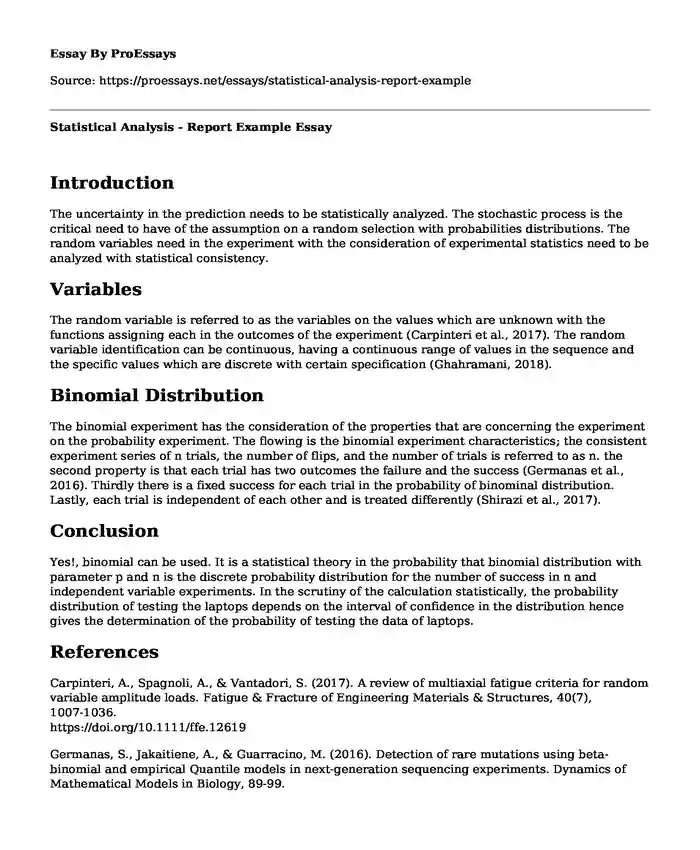Introduction
The uncertainty in the prediction needs to be statistically analyzed. The stochastic process is the critical need to have of the assumption on a random selection with probabilities distributions. The random variables need in the experiment with the consideration of experimental statistics need to be analyzed with statistical consistency.
Variables
The random variable is referred to as the variables on the values which are unknown with the functions assigning each in the outcomes of the experiment (Carpinteri et al., 2017). The random variable identification can be continuous, having a continuous range of values in the sequence and the specific values which are discrete with certain specification (Ghahramani, 2018).
Binomial Distribution
The binomial experiment has the consideration of the properties that are concerning the experiment on the probability experiment. The flowing is the binomial experiment characteristics; the consistent experiment series of n trials, the number of flips, and the number of trials is referred to as n. the second property is that each trial has two outcomes the failure and the success (Germanas et al., 2016). Thirdly there is a fixed success for each trial in the probability of binominal distribution. Lastly, each trial is independent of each other and is treated differently (Shirazi et al., 2017).
Conclusion
Yes!, binomial can be used. It is a statistical theory in the probability that binomial distribution with parameter p and n is the discrete probability distribution for the number of success in n and independent variable experiments. In the scrutiny of the calculation statistically, the probability distribution of testing the laptops depends on the interval of confidence in the distribution hence gives the determination of the probability of testing the data of laptops.
References
Carpinteri, A., Spagnoli, A., & Vantadori, S. (2017). A review of multiaxial fatigue criteria for random variable amplitude loads. Fatigue & Fracture of Engineering Materials & Structures, 40(7), 1007-1036.
https://doi.org/10.1111/ffe.12619
Germanas, S., Jakaitiene, A., & Guarracino, M. (2016). Detection of rare mutations using beta-binomial and empirical Quantile models in next-generation sequencing experiments. Dynamics of Mathematical Models in Biology, 89-99.
https://doi.org/10.1007/978-3-319-45723-9_8
Ghahramani, S. (2018). Distribution functions and discrete random variables. Fundamentals of Probability, 145-193.
https://doi.org/10.1201/9780429457951-4
Shirazi, M., Dhavala, S. S., Lord, D., & Geedipally, S. R. (2017). A methodology to design heuristics for model selection based on the characteristics of data: Application to investigate when the negative binomial Lindley (NB-L) is preferred over the negative binomial (NB). Accident Analysis & Prevention, 107, 186-194.
https://doi.org/10.1016/j.aap.2017.07.002.
Cite this page
Statistical Analysis - Report Example. (2023, Nov 25). Retrieved from https://proessays.net/essays/statistical-analysis-report-example
If you are the original author of this essay and no longer wish to have it published on the ProEssays website, please click below to request its removal:
- Data Management, Analysis, Structure, and Governance
- Paper Example on Qualitative and Quantitative Research Methods in Nursing
- Cambridge Analytica and Facebook Data Scandal Essay
- Social Research Methods Essay
- Group Research Project Reflection Paper Example
- Marxist Criticism on Mary Shelley's Frankenstein Essay Example
- Personal Statement on a Statistics Major







